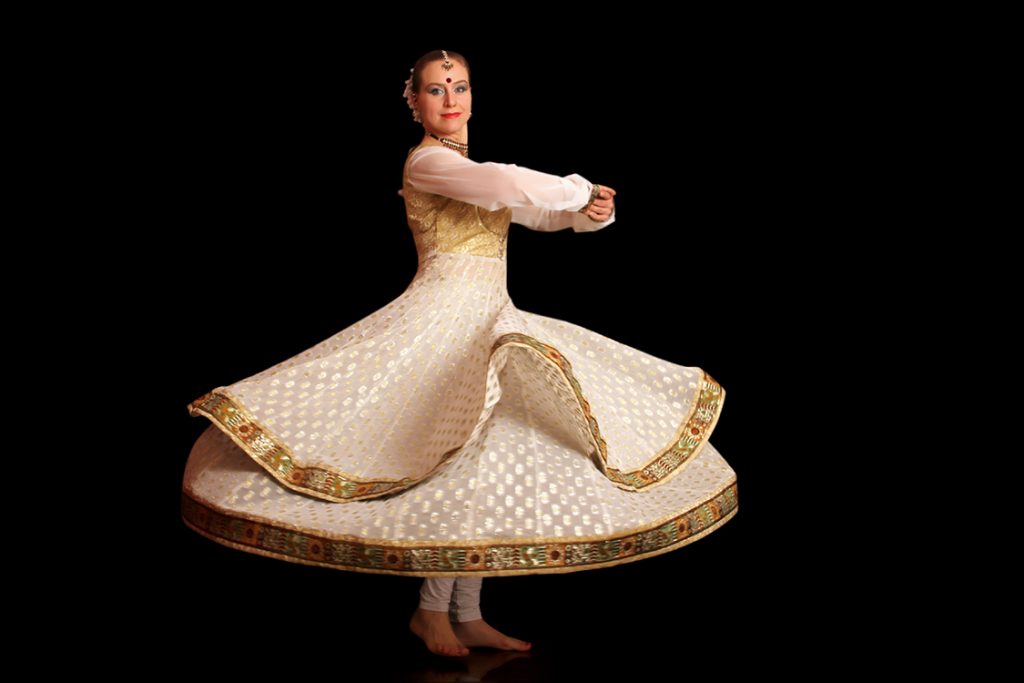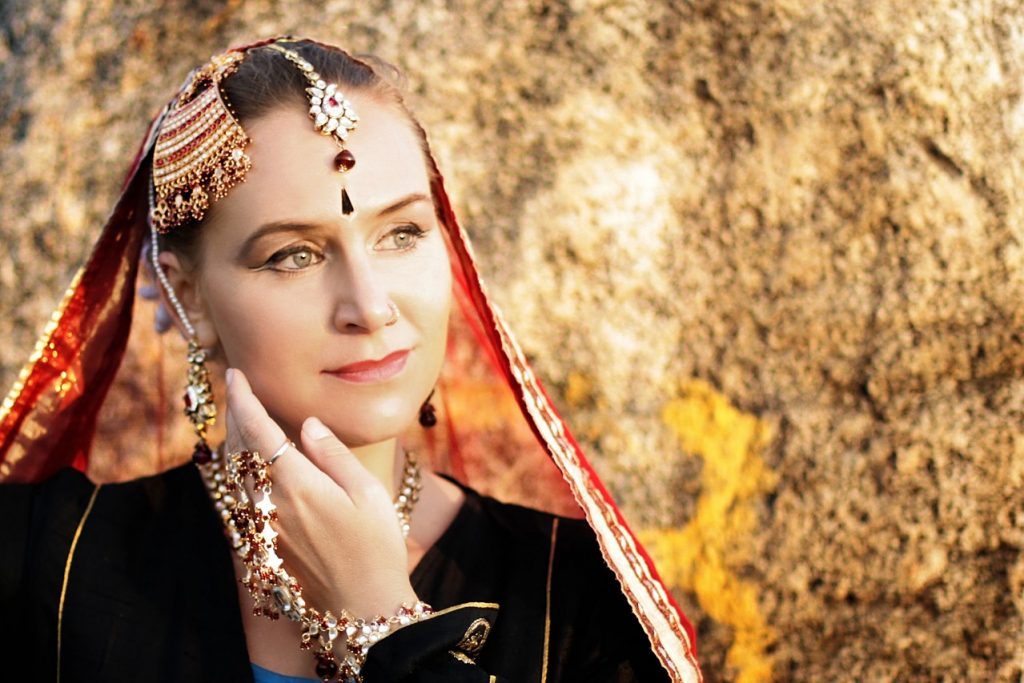The Stylistic Schools in Kathak Dance: Tradition and TransformationBy Kristina Dolinina, Kathak & Odissi Dancer (Lithuania)
Kristina Dolinina is disciple of Padmashri Guru Shovana Narayan. She is grateful to her Guru for the Kathak knowledge and constant supportin practise and research. She is an assistant professor at the Institute of Asian and Transcultural Studies, Faculty of Philosophy, Vilnius University, holding the PhD from the Department of Ethnomusicology, Lithuanian Academy of Music and Theatre.

Kathak is one of the classical dance styles currently recognized and practiced in India and beyond. This dance style has developed from performing traditions of northern central India. Kathak dance, being part of syncretic North Central Indian cultural environment, could not avoid different historical, social, political influences. In the long run, the dance style developed as an extremely versatile, synthetic performative practice, revealing the mosaic of worldviews, identities, ethnicities and belongings.

The classical[1] form of the dance was revived, institutionalised, nationalised, “purified” and “sanitised”[2] along with the other music and dance forms in the processes of reforms and freedom movement, while searching for authenticity and national identity in the end of the 19th and beginning of the 20th century. Few ‘chosen’ hereditary performers and their narrative entireties now represent the dance, leaving behind unsuitable traditions, marginalised in the turns and twists of cultural politics, power and status shifts.
 Mapping the Kathak performing communities, looking closer in to self-representation and living stories of performers, their activities and places, this study aims to investigate the relationship between tradition and transformation in the light of changing economic and socio-cultural conditions, as well as abilities and methods of Kathak performers to adapt to surrounding world.Following ethnomusicologist Daniel M. Neuman, to depict the changes in the form, content and aesthetics of the dance and steps that the dancing community takes in accordance to vicissitudes of environment, I will use the term “adaptive strategies”[3].
Mapping the Kathak performing communities, looking closer in to self-representation and living stories of performers, their activities and places, this study aims to investigate the relationship between tradition and transformation in the light of changing economic and socio-cultural conditions, as well as abilities and methods of Kathak performers to adapt to surrounding world.Following ethnomusicologist Daniel M. Neuman, to depict the changes in the form, content and aesthetics of the dance and steps that the dancing community takes in accordance to vicissitudes of environment, I will use the term “adaptive strategies”[3].
The object of the study is gharānā[4]institution – the stylistic school of the dance form and unit of socio-artistic organization. In the field of Kathak dance, the term distinctly appeared only in the beginning of the 20th century. Gharānās were connected to particular courts and outstanding dancers of the tradition. The concept of gharānā in dance was borrowed from musical gharānās of North India. Nowadays, the gharānā phenomenon raises a lot of discussion, regarding its significance.
Article shows that the concept of stylistic school is newly (re)created phenomenon, adapted by dancers and dance scholars and projected back to the past, becoming an act of politics of representation. In the beginning of the 20th century gharānās provided illusion of authenticity and ancient roots for its members and served as warrant of authority and financial sustainability in changed conditions of patronage system and spectatorship.
Nevertheless, in the times when dance was proving itself to be worth of the status of one of the national arts, it was important for performing families and crucial for the art form to establish mentioned rights of belonging.
Gharānāis only one example of entirety of features of the Kathak dance form and dancing community, that are constantly evolving, blurring, transforming and standing in long line of adaptive strategies of given tradition. Features, that keep the tradition ever changing and ever living.
Article, trough the analysing of gharānā concept, proves that the transformations of the dance community and dance form became and still are necessary and unavoidable.
Nowadays, modern India is described by such term as ‘fast development’, ‘globalization’, ‘media boom’,‘commodification of cultural objects’and ‘consuming of mass-mediated cultural forms’[5].Dance field is also becoming aggressively competitive and market-oriented. In these conditions and in recent institutional setting of dance education (as opposed to traditional teaching model from teacher to student – guru-śişya paramparā), the borders ofgharānās are disappearing, styles are mixing, giving the new forms and expressions for the dance. Gharānā concept thus, while being important in creating the dance vocabulary in the end of the 19th and beginning of the 20th century, now exists more as symbolic testimony of domination and authority.
After the introductory section of the article,I overview the concept of ghrarānā and history of particular schools, employing the method of historiographical analysis. In the later chapters of the study, I built my arguments, referring to postcolonial discourse and anthropological theory and methodology. The study is based on material from ethnographic fieldwork conducted from December 2017 to April 2018 in various Kathak communities in central northern territories of India and my own experiences as Kathak student and practitioner in Delhi from 2003 till 2010.
[1]The use of the term classical is controversial in the context of Indian dance traditions. In the treatise on performing arts Nāṭyaśāstra (5th century BCE – 5th century CE),we can find terms desi and mārgī, which can be considered having approximate meaning of folk and classical. In addition, the term śāstrīy can be used, meaning ‘related to valid treatises on performing arts’.
[2]Morcom A. Illicit Worlds of Indian Dance: Cultures of Exclusion. – Oxford: Oxford University Press, 2013. – p. 112.
[3] Neuman D.M. The life of Music in North India. The Organization of an Artistic Tradition. – Chicago and London: The University of Chicago Press, 1980. – p.26.
[4] The word gharānā comes from Hindi ghar, meaning home, lit. ‘of the house’.
[5] Appadurai A., Breckenridge C.A. Public Modernity in India // Consuming Modernity. Public Culture in a South Asian World. – Minneapolis, London: University of Minnesota Press, 1995.- p. 2,6,7.
To read the full article kindly subscribe to the Magazine…





